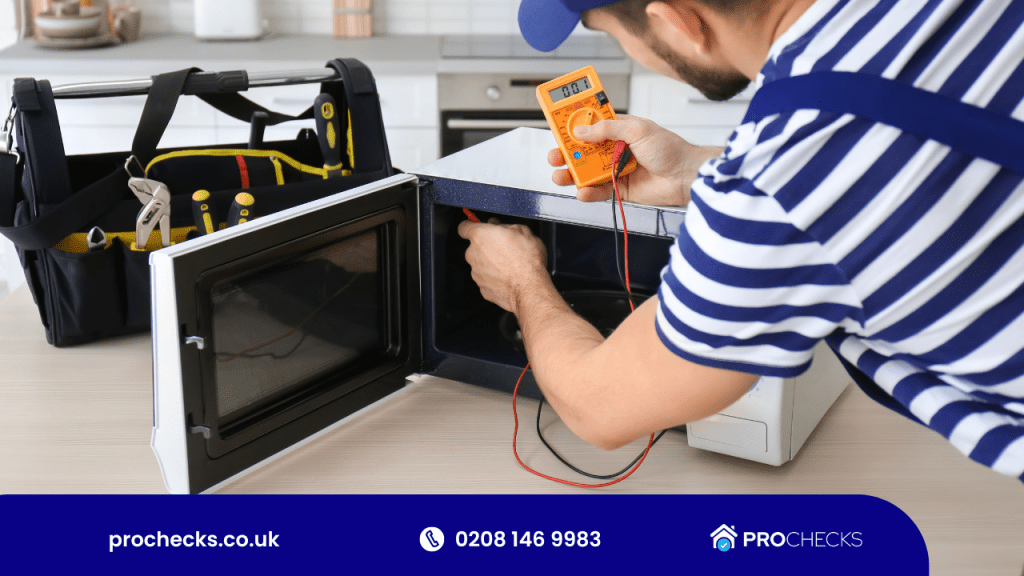The Portable Appliance Test (PAT) is a critical procedure designed to ensure that portable electrical appliances meet rigorous safety standards, thereby safeguarding users from potential hazards. The process, encompassing both visual inspections and detailed electrical testing, verifies the operational integrity of these appliances and reinforces the safety protocols within an organization. Conducting a PAT holds significant implications for safety compliance and appliance usage longevity. As we explore the nuances of this procedure, one might consider how the evolving standards and technologies could impact the effectiveness and necessity of PAT in the modern workplace. Let’s understand What Is a Portable Appliance Test Procedure?
what is PAT Testing
Portable Appliance Testing (PAT) is a systematic procedure conducted to evaluate the safety and operational integrity of portable electrical devices. This process is crucial to workplace safety protocols, ensuring that all portable electrical equipment meets rigorous safety standards.

The PAT testing overview encompasses both a visual inspection and a detailed examination using specialized testing equipment, which assesses the earth continuity, insulation resistance, and lead polarity to verify compliance with current safety regulations.
Effective PAT testing plays a pivotal role in safety compliance, mitigating the risk of electrical hazards by identifying and rectifying potential equipment failures before they result in injury or damage. It involves categorizing appliances based on their design and usage characteristics, which dictates the complexity and frequency of the tests they require.
This categorization ensures that each item is appropriately tested for safety per its potential risk factors.
Professionals conducting PAT must possess a comprehensive understanding of electrical safety and the specific testing protocols for various types of appliances. Their expertise ensures that each piece of equipment is meticulously inspected and certified, thereby upholding the highest standards of electrical safety and compliance.
Importance of PAT Testing
Understanding the systematic procedure of Portable Appliance Testing sets the stage for appreciating its significance in maintaining workplace safety.
Portable Appliance Testing (PAT) is crucial in verifying that electrical appliances meet rigorous safety standards, thus safeguarding both the equipment and the individuals using them. This process not only detects potential electrical faults but also ensures compliance with the Electricity at Work Regulations 1989, which mandate the maintenance of electrical systems to prevent danger.
PAT testing plays a pivotal role in reinforcing workplace safety by systematically identifying and mitigating risks associated with the use of electrical equipment.
Failure to adhere to these safety protocols can result in severe consequences, including electrical fires, equipment malfunctions, or even fatal accidents, thereby emphasizing the importance of regular PAT assessments.
Furthermore, these tests support a culture of safety and responsibility, essential for upholding an organization’s reputation and operational integrity.
Classes of Electrical Appliances
Electrical appliances are categorized into three distinct classes based on their design and safety features, each requiring specific testing protocols to ensure operational safety.

This classification supports effective risk assessment and enhances the precision of appliance categorization, which is crucial for maintaining safety standards in various environments.
Understanding the distinctions between these classes is essential for implementing appropriate safety measures and conducting thorough Portable Appliance Testing (PAT).
- Class 1 Appliances: These require a connection to the earth’s pin in the plug to ensure safety. They are made primarily of metal and need both insulation and earth continuity tests. Examples include refrigerators, microwaves, and other large appliances.
- Class 2 Appliances: Featuring additional insulation, these do not connect to the earth. They are generally made of plastic and require insulation testing but no earth continuity test. Common examples are hairdryers and electric drills.
- Class 3 Appliances: These operate at very low voltages and are the safest class, typically powered by external transformers. Visual inspections are often sufficient for these appliances, which include items like battery chargers and LED lamps.
- Appliance Categorization: Proper categorization helps in identifying the specific testing protocols necessary for each class, thereby minimizing risk and enhancing safety management.
Steps in PAT Testing
The process of Portable Appliance Testing (PAT) begins with a thorough pre-test preparation phase, which is crucial for ensuring the efficiency and effectiveness of the subsequent steps.
After initial preparations, the PAT procedure unfolds through several detailed phases, each adhering to stringent safety standards and utilizing advanced testing techniques.
First, a formal visual inspection is conducted. This examination checks for any visible signs of damage or wear, such as frayed cords, damaged plugs, or malfunctioning switches. It is a critical step, as many potential hazards can be identified visually without the need for electrical testing.
Following the visual assessment, electrical testing begins, tailored to the class and specific requirements of the appliance. For Class 1 appliances, this includes tests for earth continuity, insulation resistance, and lead polarity to ensure they meet the required safety standards.
Class 2 appliances, which do not require earth continuity checks, undergo rigorous insulation resistance tests to verify adequate insulation and prevent accidental electric shocks.
Each test is meticulously performed using calibrated PAT equipment to ensure reliability.
The results are then documented comprehensively, creating an audit trail that supports ongoing safety management and compliance with regulatory standards.
Frequency and Requirements
After detailing the steps involved in PAT testing, it is pertinent to address the frequency and requirements that govern these procedures. The establishment of testing intervals and the execution of a comprehensive risk assessment are critical components that ensure the safety and compliance of portable electrical appliances.
These factors are influenced by several criteria:
- Type of Equipment: Different classes of appliances, as defined in earlier sections, have varying risk levels which dictate the frequency of tests.
- Environment of Use: Appliances used in more hazardous or demanding environments require more frequent testing to mitigate potential risks.
- History and Condition of Equipment: Older appliances or those with a history of repairs may necessitate more frequent checks.
- Regulatory Requirements: While specific laws may not prescribe exact intervals, they do mandate that electrical equipment must be maintained in a safe condition, thus influencing the periodicity of PAT testing.
The frequency of PAT testing is not uniformly fixed and should be tailored based on a detailed risk assessment process. This process evaluates the likelihood of equipment failure and the potential consequences, ensuring that testing schedules are appropriately rigorous yet practical.
Mastery of these elements supports compliance with safety standards and fosters a secure operational environment.
Costs and Validity
Understanding the costs associated with Portable Appliance Testing (PAT) and the validity period of the test results is essential for effective budgeting and compliance planning in any organization.

The testing costs can vary significantly depending on the volume of appliances, the environment in which they are used, and the frequency of tests required. High-risk settings, such as industrial environments with heavy machinery, generally incur higher costs due to the complexity and the rigorous testing needed. Conversely, low-risk environments, like office spaces with fewer and less complex appliances, typically face lower testing costs.
The validity of a PAT certificate is not universally fixed but should align with the risk assessment and the nature of the appliance usage. For instance, heavily used or high-risk appliances may require certification renewal more frequently than those in low-risk categories.
It is crucial for organizations to establish a schedule that not only meets regulatory requirements but also ensures ongoing safety and efficiency.
Organizations must consider both the direct and indirect costs of PAT testing, including potential downtime during testing and the implications of non-compliance.
Strategic planning and understanding the specific needs of your organization’s operational context are vital for optimizing both safety and cost-efficiency.
Training and Resources
To ensure a comprehensive understanding and proper execution of Portable Appliance Testing (PAT), a variety of training courses and educational resources are available. These offerings are designed to equip individuals with the necessary skills to conduct PAT effectively and adhere to safety regulations.
Mastery of PAT requires both theoretical knowledge and practical skills, which are imparted through structured educational programs.
The following are key aspects of training and resources in PAT:
- Certified Training Programs: Accredited courses that provide both foundational and advanced knowledge on PAT, covering various types of electrical appliances and their specific testing requirements.
- Online Learning Modules: Flexible, self-paced online courses designed for individuals who require a more adaptable learning schedule. These modules often include interactive components such as quizzes and virtual simulations.
- Hands-On Workshops: Practical workshops that offer real-world experience with the latest testing equipment and methodologies. These are essential for understanding the nuances of different appliance classes.
- Resource Libraries: Extensive collections of manuals, guidelines, and case studies that serve as valuable references for both novice and experienced testers.
These training methods and the availability of comprehensive resources ensure that PAT technicians are well-prepared to implement safe and effective testing protocols, thereby enhancing workplace safety and appliance reliability.
Continuous Improvement Strategies
Building on the foundation set by comprehensive training and resources, continuous improvement strategies in Portable Appliance Testing (PAT) focus on enhancing the effectiveness and efficiency of testing procedures. These strategies are pivotal in refining the methodologies used, ensuring adherence to best practices, and minimizing risks associated with electrical appliance use in various settings.
Critical to these improvement strategies is the integration of advanced diagnostic tools that provide more accurate and reliable test results. By leveraging cutting-edge technology, PAT professionals can detect potential electrical faults with greater precision before they lead to equipment failure or hazardous incidents. This technological integration not only boosts the thoroughness of inspections but also enhances the overall safety environment, aligning with stringent risk management protocols.
Furthermore, continuous improvement in PAT involves regular feedback loops from technicians and clients, which help in fine-tuning the testing process. This feedback is systematically analyzed to identify recurring issues or patterns that could indicate a need for changes in testing frequency or techniques.
Conclusion
In conclusion, Portable Appliance Testing (PAT) is an essential practice that ensures the safety and functionality of electrical devices. By adhering to rigorous inspection and testing protocols, organizations can mitigate electrical hazards, comply with regulatory standards, and maintain operational integrity. Continuous engagement with updated training resources and adherence to established testing frequencies and procedures will further enhance the effectiveness of PAT, safeguarding both personnel and equipment in various institutional and commercial environments.









